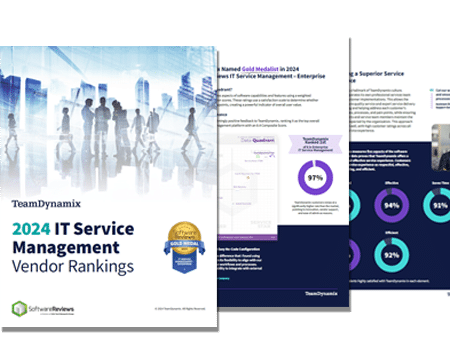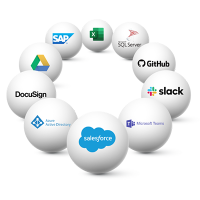
Understanding Change Management and Its Importance Within Your Organization
Did you know that a significant number of IT incidents occur when someone makes a change to one system that then affects other systems in

The Info-Tech ranking report offers a unique view of the market based entirely on in-depth customer interviews. Download the Info-Tech ITSM Quadrant and Customer Viewpoint report today.

We’ll show you some of our best situations and show you exactly how to execute them to get immediate results. The best part is, iPaaS tools often feature easy-to-use click and drag functionality, meaning you don’t need a dedicated employee building integrations and workflows.

System Integrators, Value Added Resellers, Technology Providers, and Buying Consortiums can benefit from a partnership with TeamDynamix.

The Info-Tech ranking report offers a unique view of the market based entirely on in-depth customer interviews. Download the Info-Tech ITSM Quadrant and Customer Viewpoint report to gain a better understanding of key vendor strengths and emerging market requirements.
Organizations across almost all industries tend to experience challenges stemming from bandwidth issues, the ever-increasing number of service requests, the increasing use and demand for technology and the ongoing usage of disparate systems across departments. These issues tend to cause resource constraints, gaps in service and overall end-user grief.
Take something that is seemingly simple: onboarding a new employee. This overall function typically involves IT, human resources, security and facilities. Usually, this means multiple requests into different platforms, perhaps a series of emails and maybe even phone calls. Under normal circumstances, the process is can be very manual and can take days or even weeks to complete. And while an enterprise service management (ESM) platform can help mitigate the back and forth – an ESM platform with enterprise-level automation and integration is better.
Across so many industries, from financial services and utilities to the public sector, education and healthcare, the prevalence of disparate systems and workflows tend to cause unnecessary gaps in service, time lags and poor use of resources. This is why IT leaders are moving toward a single platform approach.
Imagine that instead of entering requests into multiple systems, there is a single portal that will take the initial onboarding request. Once the request has been submitted, it will parse out the tasks and assign the appropriate task to the various departments, such as requesting equipment from IT, clearance from security, badge processing from facilities and benefits onboarding from human resources.
IT teams also benefit and can manage the rollout of new software and servers, automatically route tickets and enable employees to submit requests via self-service tools. The possibilities are endless and will become even more sophisticated as states and municipalities develop smart city projects, integrate with the Internet of Things (IoT) and implement innovative mobile services.
For organizations looking to improve service and project delivery while battling limited resources and tight budgets, a one-platform approach to managing services and projects could be the answer. Here’s why – by using a single platform for IT service management (ITSM)/ESM and project management (PPM) you can better understand your resource capacity and plan accordingly.
Resource capacity planning allows you to get a big-picture view of your entire IT organization, allowing you to balance workloads across projects and support; and to see the different types of work that need to be done at any given time.
For example, if you have three IT technicians that need to cover three functional areas of business – like service, projects and operations – you can engage in resource capacity planning and optimize each technician’s workload based on their skill set and their availability. As a result, the work can be completed more effectively and efficiently as each technician is focused on work that plays to their strengths. And because you have a full view of the work and the time it will take, you can avoid overcommitting or underutilizing your resources.
The benefits of a one-platform solution for ITSM and PPM are enhanced even more when you can include an integration component. By combining iPaaS (integration platform as a service) you’re your ITSM/PPM platform you can automate both complex and simple tasks, as well as connect disparate systems throughout your organization.
Employees no longer need to spend time on the repetitive, mundane tasks they normally have to complete before working on bigger projects – things like system name changes, resetting passwords, or granting certain permissions to software. All of these, and more, can be automated with workflows using iPaaS.
If you chose a codeless platform for this, you get the added benefit of anyone being able to use these tools – not just IT. By allowing lines of business to create their own workflows you can free up your IT resources to work on larger projects and eliminate the logjam when it comes to integrations within your organization.
Here are a few other ways iPaaS can supercharge service delivery and reduce the IT drain on an organization:
Want more ITSM best practices? Check out – ITSM Best Practices: Automating IT Service Management.
This article was originally posted in October 2019 and has been updated with new information.

Did you know that a significant number of IT incidents occur when someone makes a change to one system that then affects other systems in

The construction industry can be very volatile, with a high employee turnover rate due to seasonal fluctuations in the workforce. A key challenge for the

A study from Information Week and TeamDynamix shows companies are looking to invest in IT Service Management (ITSM) software that is simple to administer and
TeamDynamix’s award-winning SaaS cloud solution offers IT Service and Project Management together on one platform with enterprise integration and automation.
[email protected]
(877) 752-6196
Contact Us
